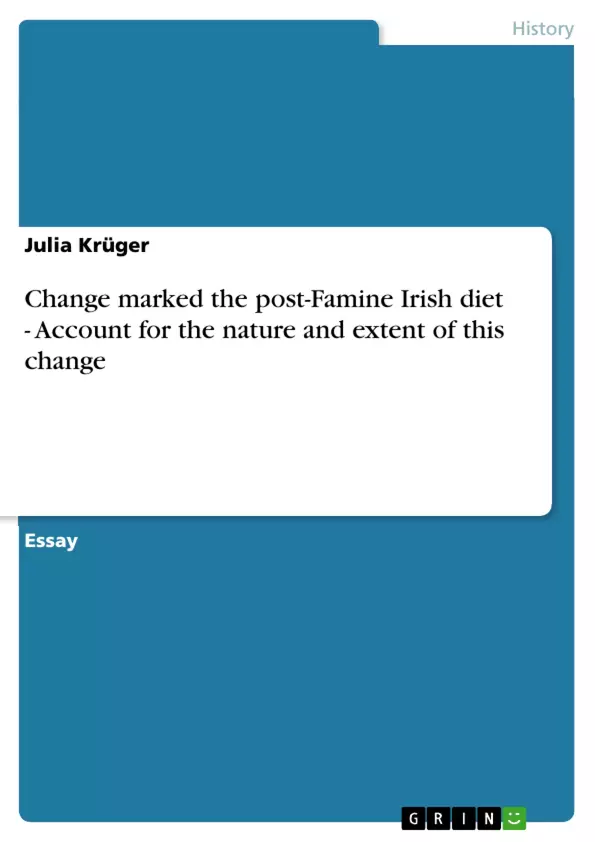The Great Famine between 1845 and 1849 was one of the main events, if not the essential event of Irish history. Not only in the context of demographic decline that was caused by mass starvation, death and emigration. The population of Ireland nearly cut in half from c. 8 million, in 1841, to c. 4 million people around 1910. An interesting fact is also, the Great Famine marks the watershed for Irish living situation. This view is supported by Kevin O’Rourke who identifies the post-Famine development of the Irish society in the following way: ‘Corresponding to this turnaround in population was a turnaround in living standards’ (O’Rourke, 1995: 410). As soon as Ireland was over the years of privation, conditions of life improved rapidly. Especially the post-Famine food consumption can be linked directly to the better living standard after 1849.
Inhaltsverzeichnis (Table of Contents)
- Introduction
- The Great Famine: A Watershed Moment
- The Potato and Its Decline
- The Rise of Diversified Nutrition
- Regional Disparities and the Congested Districts Board
- The Evolution of the Rural Diet
- The Shift from Potato to Bread
- The Transformation of Irish Agriculture
- Increased Meat, Butter, and Milk Consumption
- The Rise of Tea and Sugar
- Conclusion
Zielsetzung und Themenschwerpunkte (Objectives and Key Themes)
This essay aims to explore the significant changes in Irish dietary patterns during the second half of the nineteenth century and the early twentieth century. It analyzes the factors that led to this dietary shift, focusing on the decline of the potato and the rise of a more diverse food system. Here are the key themes explored in the text:- The impact of the Great Famine on Irish food consumption
- The transition from a potato-based diet to a more varied diet
- The role of agricultural changes and industrialization in shaping Irish food habits
- Regional disparities in dietary patterns and living standards
- The influence of commercial forces and increased access to shop-bought goods
Zusammenfassung der Kapitel (Chapter Summaries)
- Introduction: This section provides a brief overview of the essay's purpose and scope, highlighting the importance of the Great Famine as a turning point in Irish history and its impact on living standards.
- The Great Famine: A Watershed Moment: This section emphasizes the devastating effects of the Famine on Ireland's population and its profound impact on living conditions. It introduces the concept of a "turnaround" in living standards after the Famine and sets the stage for analyzing dietary changes.
- The Potato and Its Decline: This section delves into the pre-Famine reliance on potatoes as the staple food in Irish diets. It explores the consequences of the potato blight and how the potato's dominance in the diet declined after the Famine.
- The Rise of Diversified Nutrition: This section focuses on the emergence of a more diverse diet after the Famine, with the introduction of foods like baker's bread, tea, sugar, and meat. It emphasizes the impact of increased imports, better facilities, and higher wages on the availability of a broader range of foods.
- Regional Disparities and the Congested Districts Board: This section acknowledges the uneven distribution of improved living standards across Ireland, highlighting the continued reliance on potatoes in poorer western counties. It introduces the Congested Districts Board as a government initiative aimed at addressing poverty and promoting development in these areas.
- The Evolution of the Rural Diet: This section examines the evolving dietary patterns in rural Ireland, showing a blend of home-produced and purchased goods. It highlights the persistence of some traditional foods like potatoes, oatmeal, and buttermilk alongside the increasing influence of commercial forces.
- The Shift from Potato to Bread: This section examines the gradual shift from potato to bread consumption as a key dietary change. It explores the use of various types of flour and the rise of soda bread as a popular alternative to the potato.
- The Transformation of Irish Agriculture: This section explores the impact of dietary changes on Irish agriculture, particularly the shift from tillage to pasture and the increased production of livestock and dairy products. It highlights the significant post-Famine adjustments in agricultural production.
- Increased Meat, Butter, and Milk Consumption: This section focuses on the rise of meat, butter, and milk consumption as a reflection of improved living standards. It describes how these foods became more accessible and a part of everyday meals, compared to their former status as luxury items.
- The Rise of Tea and Sugar: This section examines the remarkable increase in tea and sugar consumption in Ireland, despite the ongoing poverty. It highlights the importance of these commodities in Irish diets, even exceeding potato consumption in certain regions.
Schlüsselwörter (Keywords)
The essay explores the themes of dietary change, food consumption, and living standards in post-Famine Ireland. Key keywords include: The Great Famine, potato, bread, tea, sugar, meat, butter, milk, agriculture, regional disparities, Congested Districts Board, commercialization, and socioeconomic development.- Arbeit zitieren
- B.A. Julia Krüger (Autor:in), 2011, Change marked the post-Famine Irish diet - Account for the nature and extent of this change, München, GRIN Verlag, https://www.grin.com/document/192657



